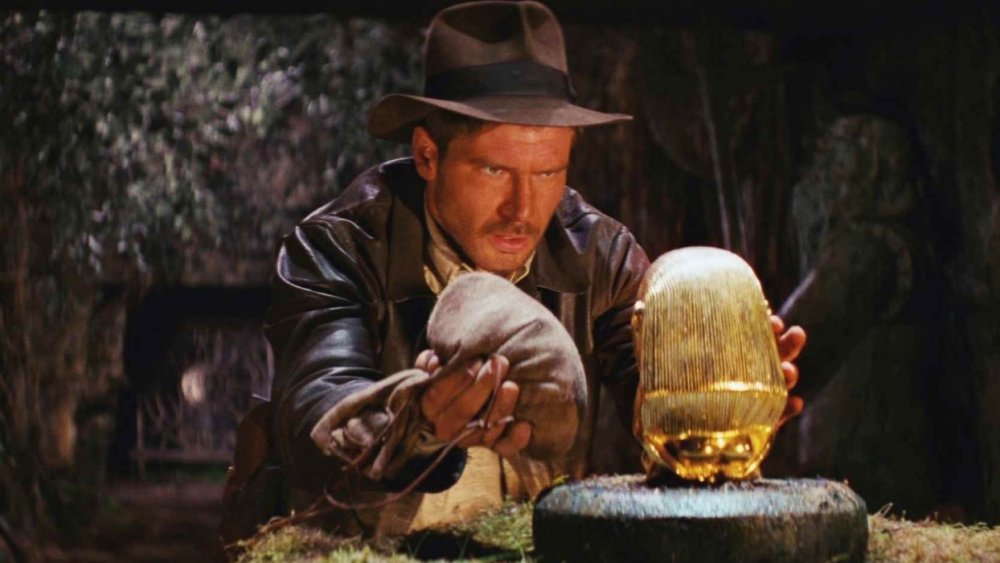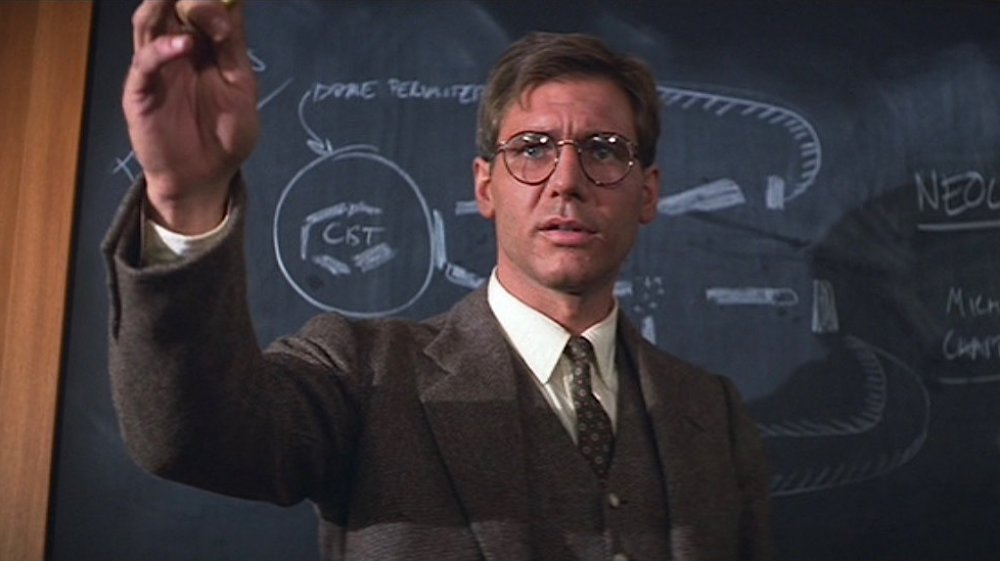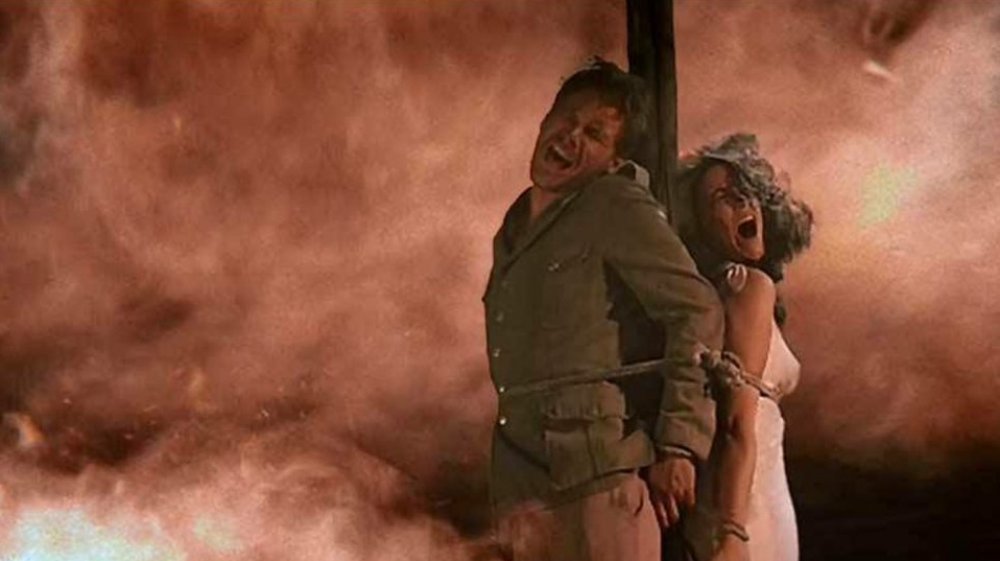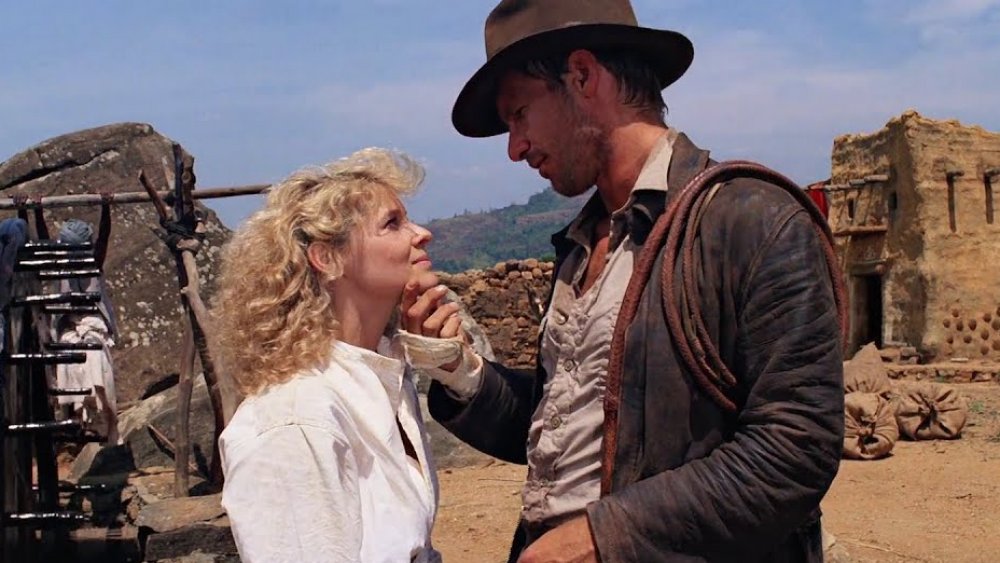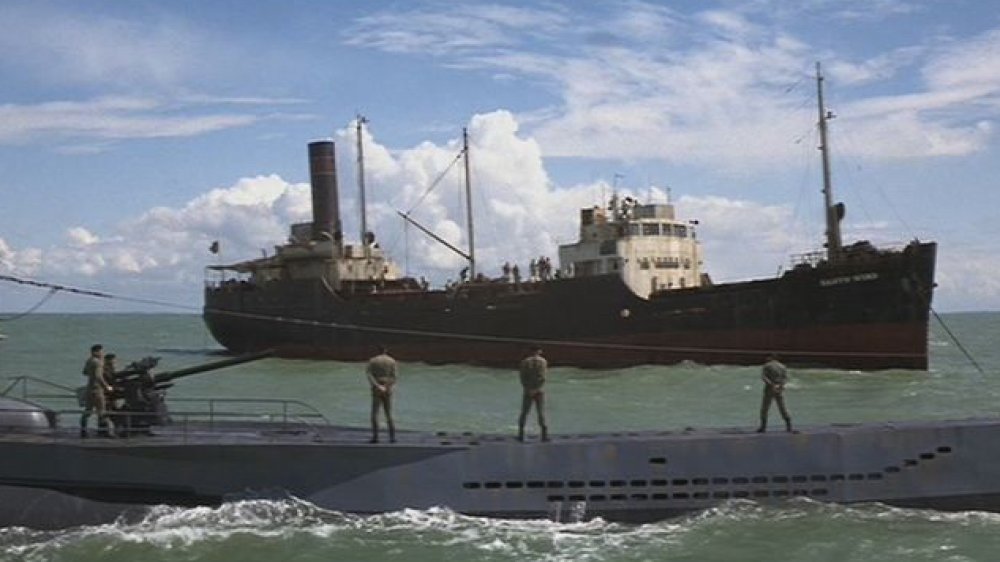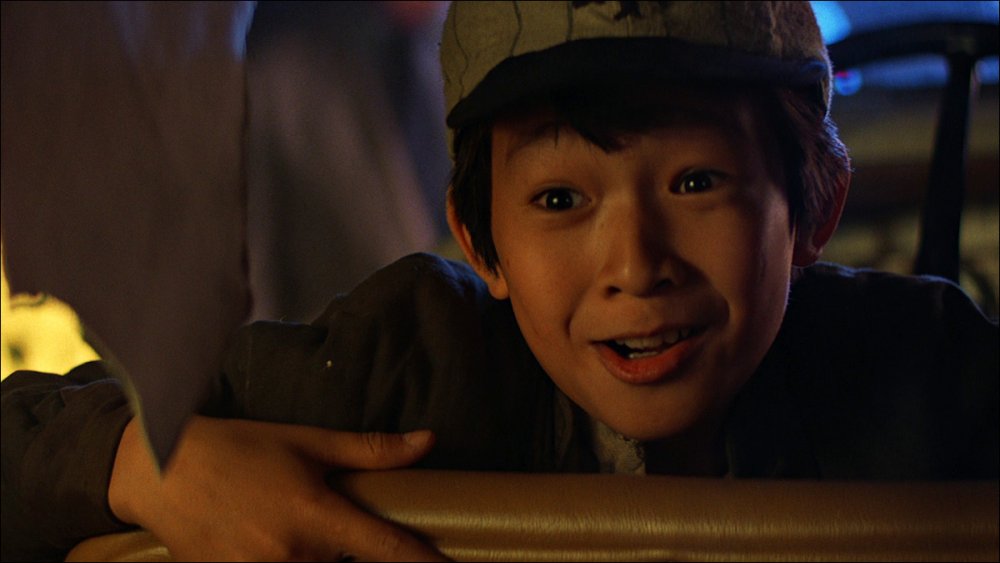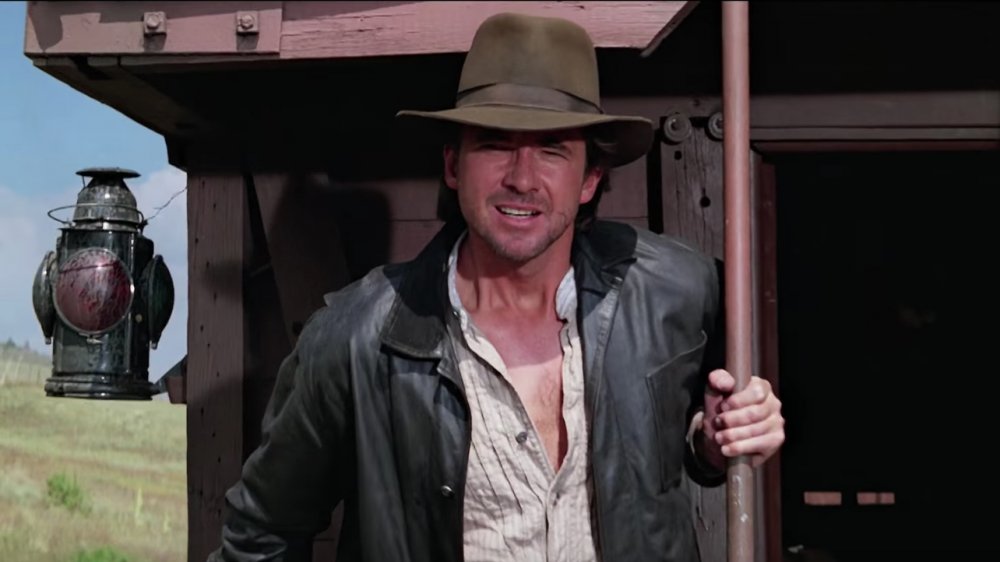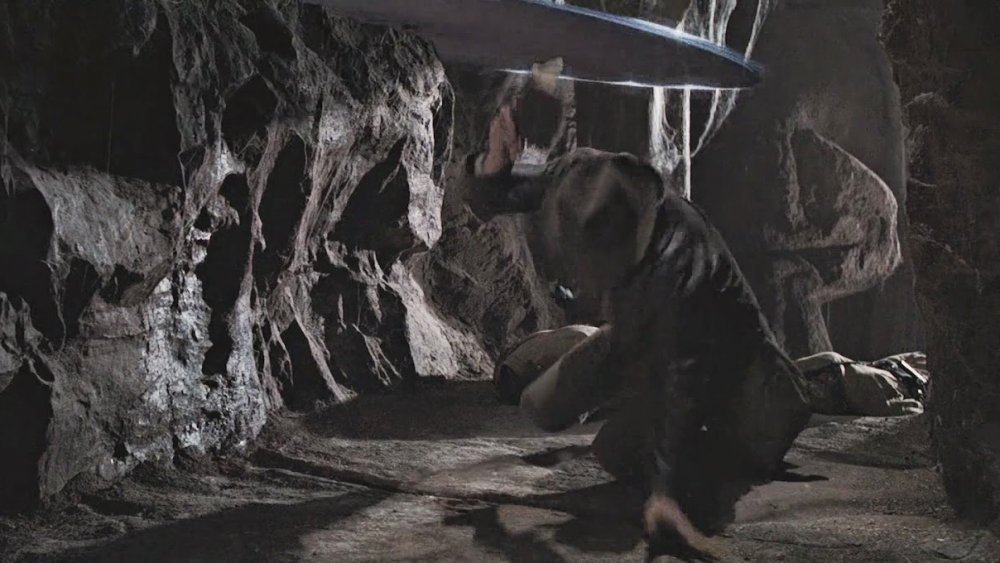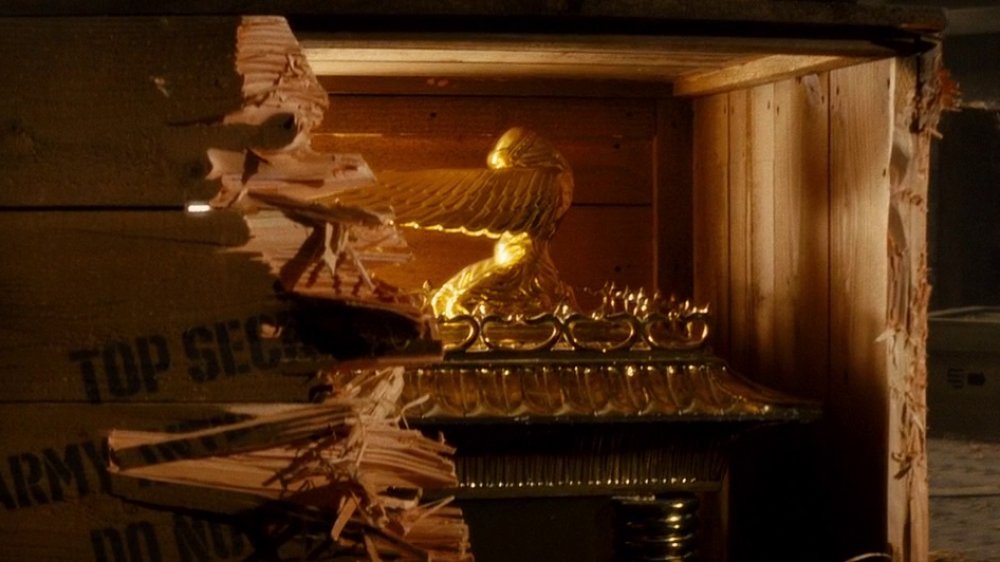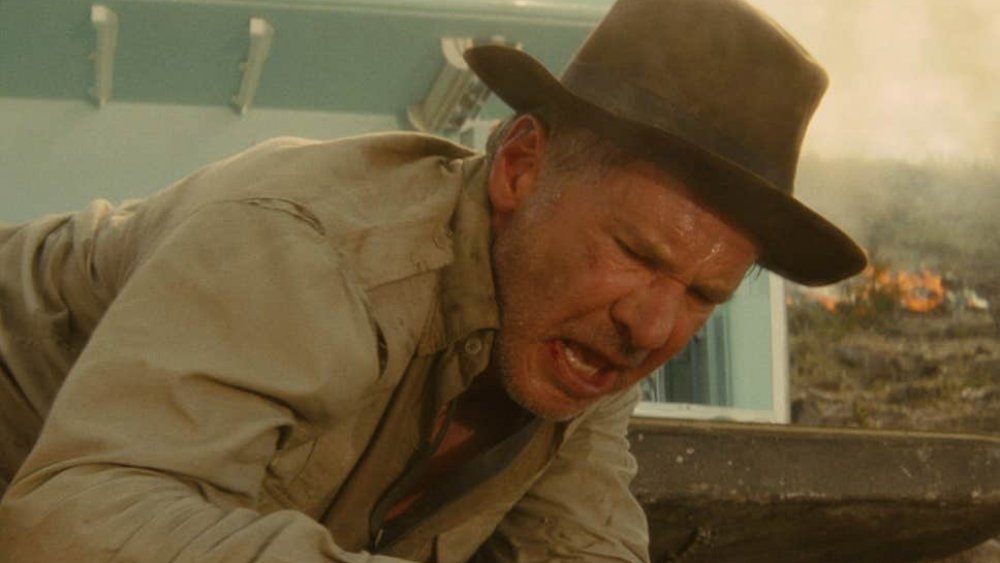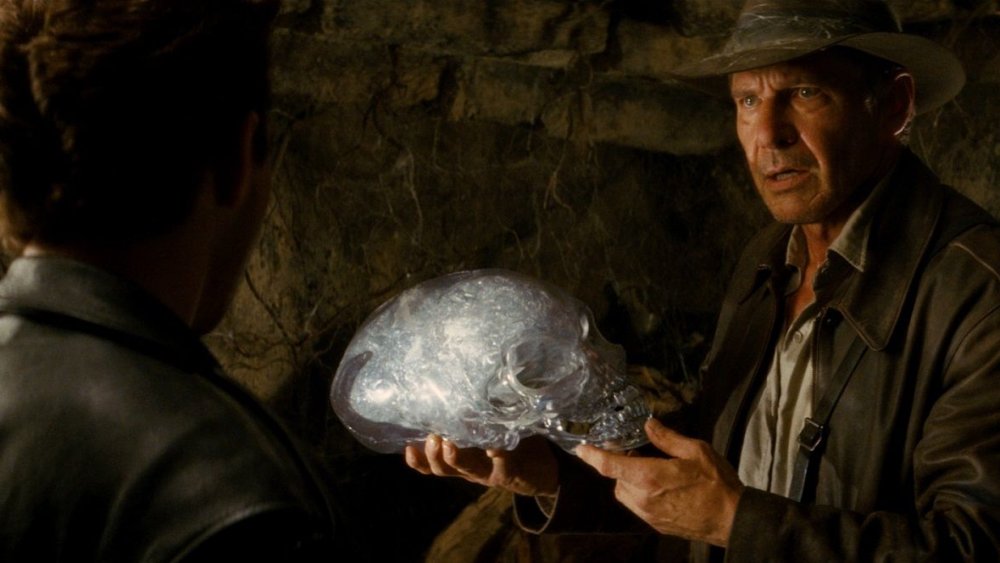Dumb Things In The Indiana Jones Movies Everyone Ignored
It's been decades since intrepid adventurer Indiana Jones made his way onto movie screens and into pop culture history. The character has solidified himself as one of cinema's quintessential heroes, having conquered every science fiction and supernatural foe in the game.
Whether it's punching Nazis in the face or succumbing to the effects of a voodoo doll, there's almost no situation that Doctor Henry Jones Jr. hasn't found himself in — and lived to tell the tale. However, when a character goes on that many adventures and is beloved by that many people, it's easy to understand that a few less-than-stellar moments may have to be ignored.
Yes, Indiana Jones is among the most beloved of film franchises, but that doesn't mean the movies are without their flaws (and if you don't agree, let us remember Mutt Williams). For every incredible scene that sees the hero running from a giant booby-trap boulder or facing down Nazis with a rocket launcher, there's a moment like the one when Indy has to eat monkey's brains instead of a rich tikka masala.
For those who love the franchise but want to take a good, hard look at its handful of flaws, here's a rundown of some of the dumb things that the Indiana Jones movies ask its viewers to ignore.
Indiana Jones is somehow still a skeptic
When Raiders of the Lost Ark opens, Indiana Jones is unfazed by his colleague's stories about ancient Biblical and magical powers that could destroy him — and everyone else seeking the Ark of the Covenant. However, by the end of the movie, he's forced to understand and accept those powers in all their face-melting glory. He even ends the movie by warning the "bureaucratic fools" in government that they've got something more powerful than they can imagine on their hands.
Furthermore, many forget that the events of Temple of Doom take place before the events of Raiders of the Lost Ark. In that movie, Indiana saw a man's heart magically ripped from his chest while still beating, personally turned magic stones white-hot by invoking the name of Shiva, and succumbed to a potion that hypnotized him into being a mindless slave. Despite bearing witness to all that, Indiana Jones is still a skeptic. In The Last Crusade, he's very quick to dismiss stories about King Arthur and the Holy Grail as "bedtime stories." He's even got his doubts about Harold Oxley's clues about the famous Crystal Skull legend.
It's one thing to try and ensure your character doesn't live in a fantastical world that's completely removed from the rest of society. However, for Jones to simply ignore some of the most exciting, perplexing and incredibly real moments of his life is just silly.
How does Indiana know not to look at the ark?
After thrilling chases, outsmarting the bad guys at every turn and a couple of failed rescue attempts throughout Raiders of the Lost Ark, Indiana Jones and Marion Ravenwood are captured by the Nazis. They're tied up and forced to witness the hellish moment when the bad guys ignore ancient safety warnings and decide to open the Ark of the Covenant to harness its power.
That's when Indy tells Marion that they can't look at the ark no matter what happens. The gambit seems to work as they stand in the midst of an ancient power cutting through a cadre of Nazis like tissue paper, but Jones and Marion are spared from its wrath. However... how in the world did Indy know not to look at the ark?
Earlier in the film, it's mentioned that the ark was hidden away due to its immense power being too much for mankind to handle, but the cheat code to close one's eyes came kind of out of nowhere. In addition, it's odd that Jones was the one to figure it out. Bible verses pertaining to the ark warn not to look into it or touch it, but Indy had seemingly been a skeptic about its magical properties. An argument could be made that he was hedging his bets in a moment of crisis, but that's a heck of a good guess to make. As it turns out, he's also warned in a deleted scene, but that's something most film viewers would never be aware of.
Indiana Jones' romantic interests
One could go as far as to say that the decision to make Temple of Doom a prequel rather than a sequel is dumb enough, but George Lucas revealed in the documentary Indiana Jones: Making the Trilogy that he wanted two things from the film. First, to not have to fight the Nazis again. Second, to have Jones' romantic interest be anyone but Marion.
A solution to both of those problems was to set the film in 1935. While that takes care of the Nazi issue, it also makes it so fans aren't worried that Jones' relationship with Willie Scott is stepping on what he had with Marion. However, given the history that Jones and Marion had prior to even Raiders of the Lost Ark, one could argue that seeing an early adventure with Indy, Marion, and her father Abner Ravenwood would have been great for the franchise. Either way, the movie owes fans an explanation as to how it reckons Jones' weirdly complicated love life with the tryst he has with Dr. Elsa Schneider in The Last Crusade — and it can be argued that Marion's return and their subsequent marriage in Kingdom of the Crystal Skull is one of that film's only redeeming qualities in the context of the franchise.
How did Indiana Jones survive the trip to Nazi Island?
In Raiders of the Lost Ark, after stealing the ark and rescuing Marion, Jones takes a ship to safety. However, their voyage is waylaid when his rival, Belloq, and the Nazis track them down in a Nazi U-boat (which is the historian's term for a submarine). Fortunately, the captain of the ship Jones boarded is a loyal friend and instructs the adventurer to hide while he lies his way out of the whole Nazi issue. Unfortunately, he's unsuccessful — Belloq's forces take both the ark and Marion.
In a heroic moment scored by everyone's favorite theme music, the crew of the ship watch with glee as Indiana swims across to the U-boat and jumps atop it before it goes underwater. The film then cuts to an island where the villains plan to open the Ark of the Covenant, but the question remains: How did Indy survive the trip?
Viewers never see him actually enter the U-boat, just wander the deck a bit. Obviously he didn't just cling to the side and hold his breath for hundreds of miles, but as far as what actually happened, the audience doesn't know. If you ask anyone that's ever worked in a submarine or been given a cursory tour, they'll tell you that the number of places for a stowaway to stow away are incredibly limited. This is especially true in this case, given the large complement of soldiers and the giant crate containing an ark that's on board.
As it turns out, the answer to this question lies in a deleted scene that shows Indy lashing onto the periscope with his whip — which still seems like an unlikely method of survival, but would have at least gone a fair way toward clearing up some confusion.
Short Round is just gone?
When Temple of Doom opens, Indiana Jones is accompanied by a young child named Wan Li, who Jones refers to as Short Round. It's later revealed that the young Chinese boy from Shanghai got busted trying to pick the archeologist's pocket and they eventually became friends. While opinions are split about Short Round, it's undeniable that he provided some comic relief — and drove the getaway car, beat up fully-grown adults, and even broke Indy from his trance in the titular Temple of Doom. By the end of the film, they both return to the small Indian village as triumphant heroes. After that... who knows?
The third movie opens with absolutely no mention of Short Round. There's not even a whisper of him in Raiders of the Lost Ark, which came after Temple of Doom chronologically. Short Round is just gone after the credits roll. Romantic partners like Willie come and go for a rugged and handsome bachelor like Jones. However, the young child he took under his wing and brought thousands of miles from his home on numerous death-defying adventures? You'd think they'd at least stay in touch — and as it happens, the authors of assorted Indiana Jones spinoff materials thought so too, because they dreamed up additional adventures for the duo.
Indiana Jones is a ripoff artist
No, we're not talking about Allan Quartermain.
Indiana Jones' brown jacket, fedora and general roguish attitude are well-recognized by movie fans far and wide. Although there have been numerous similar characters in literature, he's a unique individual persona that even the least creative Halloween enthusiast or cosplayer could recreate. That's why it's such a dumb disappointment when the opening of The Last Crusade reveals that Indiana Jones is nothing but a ripoff of a pre-existing adventurer not-so-subtly referred to in the cast list as "Fedora."
The film opens with a young Henry Jones Jr. dressed as a Boy Scout stealing the Cross of Coronado from a group of treasure hunters led by a man in, you guessed it, a brown jacket and fedora with a roguish demeanor. Young Indy impresses the older treasure hunter with his quick thinking and desire to see the artifact placed in a museum rather than sold off for cold, hard cash.
After a thrilling chase sees Jones discover his prowess with a whip and instills a lifelong fear of snakes within him, he manages to get the better of Fedora and escape with the Cross. However, the man enlists the help of the local sheriff and essentially tattles on Jones to his father. So, to recap: Jones rips off his entire look from a guy that wasn't fit to lick adult Indy's mud-covered boots. Overall, it's a pretty disappointing reveal that's meant to give insight into Jones' character.
Kneel (and roll?) before God
The Last Crusade's climactic scene sees Indiana Jones forced to face three ancient trials to obtain the Holy Grail and use its healing properties to save his father — who was shot by a real jerk in an effort to give the already highly motivated adventurer a kick in the pants.
The first trial asks the "penitent man" to "kneel before God," which ends up being a clue that Jones has to kneel in the temple in order to avoid a buzzsaw booby trap that's positioned to cut him in half at the hips. It's a pretty interesting riddle that Jones figures out at the last second. However, there's more to the trap, and it's unclear why.
Just after kneeling, Jones instinctively does a danger roll to avoid a second buzzsaw that comes up from the floor. This would have cut him in half from the feet up (which is a pretty gnarly way to die, but that's neither here nor there). This begs the question, though: Why in the world is there a second buzzsaw? The clue asks the person to kneel, but if they follow instructions, they run the risk of being able to booty grind with themselves on a dance floor moments after.
It may seem nitpicky to question an ancient booby trap, but the three trials are meant to set Indy apart from the many who have sought the Grail beforehand, so they should really make sense.
The Ark comes back
Raiders of the Lost Ark ends with a memorable shot of the Ark of the Covenant being wheeled into a U.S. government warehouse filled to the brim with similar crates. It implies that the whirlwind adventure that audiences just saw was one of many in the world that the feds are keeping track of — and storing their attendant artifacts away for a rainy day. It helped establish the world of Indiana Jones as one that's way more vast than meets the eye.
In Kingdom of the Crystal Skull, Indiana Jones and his cohort are brought to that warehouse by the Soviets. While there, Jones is tasked with finding a different artifact at gunpoint. He does some thrilling stunts to knock out and escape his captors, including crashing a truck through several of the crates. While most are seemingly revealed to be empty, one shot reveals that Jones knocked the Ark of the Covenant out of place. Just like that, the vast world of magic and intrigue established in Raiders of the Lost Ark shrinks down in a big hurry.
While it's a fun nod to Indy's illustrious past, it also waters down everything that made that last shot of Raiders of the Lost Ark so incredibly fun. Gone is any mystery of what's inside that government warehouse — instead, it's just another cheap set piece for an Indiana Jones fight.
The refrigerator...
It would be hard to write a list of dumb things in the Indiana Jones movies, or movies in general, without mentioning the infamous refrigerator nuke scene. Kingdom of the Crystal Skull opens with a sequence that brings Jones back to the world of adventure after nearly two decades away. He fights off a group of Russians, learns a trusted friend betrayed him, and eventually finds himself in a small town in the middle of the Nevada desert. As he looks around, Jones notices that all the residents are mannequins. It becomes apparent that he's at a government nuke testing site and is literally one minute away from being blown to smithereens.
Faced with imminent doom, what does Indy do? He empties out a lead-lined refrigerator — which happens to be fully stocked in the uninhabited test range — and hides inside. The ensuing blast hurls him a great distance, and when he lands, he tumbles out of the appliance completely unscathed to share a moment with a CGI gopher.
There's not much else that can be said about this scene other than that we've come an awful long way from the days when Indy solved his problems by punching Nazis.
Magic, sure, but aliens?
There's a lot to be upset about in Kingdom of the Crystal Skull. It shoehorns Indiana Jones' son into the narrative, it has way too much CGI, and more importantly, it shifts the genre of the franchise away from fantasy and more to science fiction.
Now, there's nothing wrong with a good science fiction story, but for it to come in the fourth installment of a franchise after a nearly 20-year gap just feels jarring and unnecessary.
The movie ends with Jones and his cohorts finding a collection of alien skeletons with one missing head. They are eventually referred to as "interdimensional beings," but it's not quite clear what that means. After returning the infamous crystal skull, the aliens come to life and vacate Earth in a flying saucer.
Indiana Jones is a guy that frequently comes across the fantastical in his pursuits of ancient and mysterious artifacts. However, there's nothing ancient nor mysterious about a flying saucer. It ups the technology of the day and just feels out of place in a world that's gotten its audience used to magic by that point. In short, never switch your genre in movie four.
